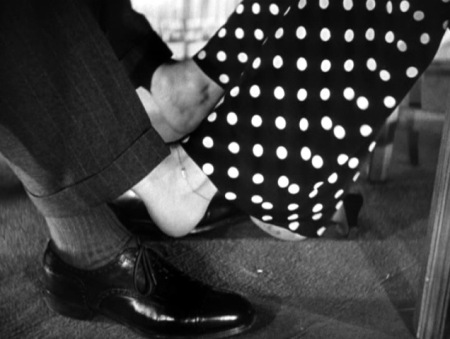
Snub Pollard (and unidentified frail) in YOUNG MR. JAZZ, a Harold Lloyd-Bebe Daniels comedy from 1919. Very nice, slightly disposable sort of film. To be really memorable, Harold needs more at stake, and he needs to suffer more. In this one he’s beset by an entire bar-room full of plug-uglies, and it just isn’t enough.

But Snub turning up like this reminded me of his surprise appearance in 1960’s WHO WAS THAT LADY?, playing a terrifying illustrated man. He has the job of tattooing the sole of Tony Curtis’ foot for plot reasons, which he sets about with grim relish.

Wasn’t going to write about WWTL? because we really couldn’t get on with it. It’s full of the sexism of that era, courtesy of scribe Norman Krasna. George Sidney directs with appropriate vulgarity, but the whole thing is too sinister, Snub’s alarming appearance being an early symptom.
New York chemistry professor Tony Curtis (!) is caught kissing or, as he argues it, being kissed by, a foreign exchange student. The one who catches him is Mrs. Curtis, AKA Janet Leigh. Curtis turns to TV scenarist friend Dean Martin to invent an alibi. Dino proposes that Tony is in reality and FBI agent and that he was kissing the girl as part of a mission. Of course, this pretense leads to real spy stuff (eventually) and lots of stress for the real FBI, who are all presented as chronically dyspeptic and long-suffering schmoes.

The main interests, in the absence of laughs, are the strange inverted resemblance to TRUE LIES (in which Arnie really IS a secret agent but his wife thinks he’s cheating on him, if memory serves, and she’s played by Janet & Tony’s daughter) and the deeply unpleasant nature of Dino’s character, which of course he plays to the hilt while apparently thinking he’s being charming. Having invented the foolproof cover story for infidelity, he then blackmails Tony into joining him on a double date (with the pneumatic Joi Lansing and her wobbleganger). Dino’s unseemly interest in forcing his best friend to have extramarital sex leads Tony to denounce him, quite accurately so far as we can see, as a psychopath. Superficial charm, pathological lying, complete lack of moral compass… yep, that’s Dino, or at any rate his screen persona in so many films one starts to wonder.

The whole thing ends with a kind of mushroom cloud hovering over the Empire State Building — just as the comedy terrorists in TRUE LIES are probably part of the reason that movie seems to have been written out of James Cameron’s CV, this lively yet ugly entry from George Sidney seems unfortunate whenever it’s interesting, and boring whenever it’s on track. Need to watch his SHOWBOAT or something as a palate cleanser.








